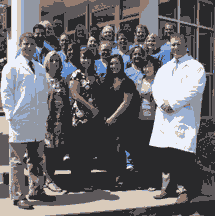Prostate Cancer Awareness Month
By Dr. George W. Privett Jr.
Though it?s not the most comfortable of topics, prostate cancer diagnosis and treatment affects so many of us today. There is a one in two chance that a man will develop prostate cancer, as he ages. Most cases of prostate cancer are detected by elevation of a blood test, Prostate Specific Antigen (PSA) and/or Digital Rectal Exam (DRE).
The great majority of Prostate ?cancers? are benign and without symptoms. The two major treatments for the disease are radical surgery and x-radiation, both of which will likely have two serious life altering side effects ? impotence and incontinence. Radical surgery with or without robotic assistance is particularly prone to immediate symptoms of impotence and incontinence and some prostate cancer specialists recommend against surgery at all.
A third plan of attack is to use new MRI imaging techniques to determine if a tumor can be found, where it is, its size and the likelihood of it being malignant. If a tumor is identified that looks suspicious, then a targeted biopsy can be performed and a rational treatment plan designed. If no tumor is identified or if a biopsy shows low or medium grade tumor, then ?watchful waiting? or active surveillance can be the best choice and avoid any complications. If high grade tumor or cancer is detected, the more definitive treatment or external radiation and/or radium seeds will be good options, with or without hormone treatment.
When faced with an elevated PSA, men should know their diagnostic and treatment options in order to make an informed decision that is best for them. Prostate cancer, whether low grade or high grade, does not require an emergent or urgent decision and there is plenty of time to do your own research and get several opinions, not only from Urologists, but also from Radiation Oncologists and Medical Oncologists. Support groups such as UsToo can give valuable information.
A good place to start is the Prostate Cancer Research Institute (PCRI), whose founder, Mark Scholz, MD, a Medical Oncologist specializing in Prostate Cancer diagnosis and treatment. PCRI can be found on line at http://www.prostateoncology.com/
Lexington Diagnostic Center & OPEN MRI offers multi-paramentic MRIs of the prostate which can demonstrate the presence/location or the absence of cancer. This test utilizes an MRI of the pelvic area with and without contrast enhancement using a surface coil. (Contrast is a substance injected intravenously to enhance the visibility of blood vessels, follow the movement of blood and detect abnormal tissue.)
Visualizing cancer within the prostate has been difficult because the prostate is small and deep in the body. Random blind biopsies have been the main diagnostic tool. However with prostate MRI, physicians can more easily perform targeted biopsies or opt for active surveillance.
?There is a lot of confusion in prostate cancer diagnoses stemming from unclear results and recommendations for when men should have a biopsy,? said Dr. George Privett, Medical Director, Lexington Diagnostic Center & OPEN MRI. ?By using modalities such as magnetic resonance imaging (MRI), we can more accurately localize and stage prostate cancer while potentially minimizing the number of prostate biopsies a patient may require. This is a significant diagnostic tool, and can add potentially life-saving enhancement to the diagnosis and treatment of disease.?
Prostate-specific antigen, or PSA, is a protein produced by cells of the prostate gland. The PSA test measures the level of PSA in a man?s blood. For this test, a blood sample is sent to a laboratory for analysis. The results are usually reported as nanograms of PSA per milliliter (ng/mL) of blood. The blood level of PSA is often elevated in men with prostate cancer, however, PSA may be elevated in several non-cancer conditions, such as BPH (or benign prostatic hypertrophy) and chronic prostate infections).
Call now to compare and save on your out-of-pocket expenses (859) 278-6724
1725 Harrodsburg Road
Suite 100
Lexington, KY 40504





 [/frame]
[/frame] [/frame]
[/frame]